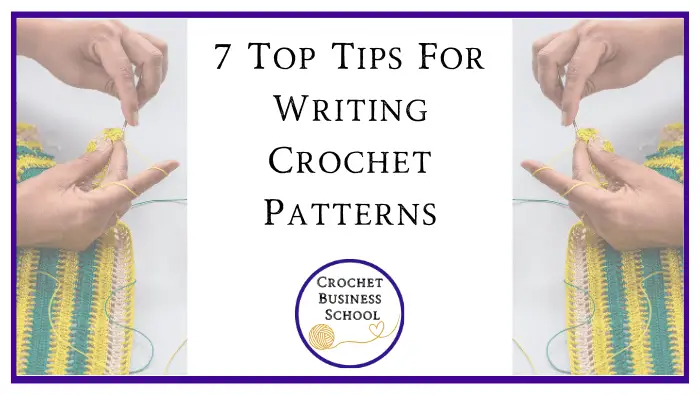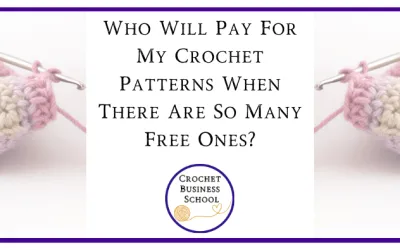Writing your own crochet patterns is a really smart move to bring constant, semi passive revenue into your crochet business. Unlike selling what you make, with crochet patterns you do the work once then sell them over and over again. And of course, the more patterns you have available the more money you will make. So it makes really good sense to start writing and selling your own crochet patterns so you can make money without having a huge to do list after you make the sale.
But how do you go about writing and selling your own crochet patterns? What is involved and what do you need to know and do so that you end up with happy customers?
Well here are my 7 top tips for writing crochet patterns
This article contains affiliate links, I may receive a commission for purchases made through these links
1 Choose a design that suits your audience
Before you even start the design process, you need to make sure that you’re choosing a design that your audience will love. You want your pattern to be a success as soon as its released, and to give your pattern the best chance of doing this, you need to be choosing a design you know that your audience will love as soon as they set eyes on it.
If your audience love making bags, but you offer them a wall hanging then the chances are that you will make fewer sales than usual.
Selling patterns is much like selling what you make, in that your customers need to know what to expect from you. So choose a design that you’re audience are sure to love.
2. Use standard terminology
There is nothing more frustrating than picking up a pattern where you don’t immediately recognise the terms being used. Make sure that your directions are clear, and use the standard abbreviations as set out by the Yarn Craft Council. Also make sure that when you proof read your pattern, that you use the same terms throughout.
The chances are that you will be using terms and abbreviations that you have read yourself in patterns you’ve made before. So if you’re a bit unsure of which term or how to word an instruction, then its a great idea to go and check how other designers have worded something similar. This is not cheating or plagiarising, as you are only using other patterns to check wording, not copying the design itself. So don’t be afraid to use all tools that are at your disposal to reassure yourself that you are wording your instructions in a way that is widely accepted and understood.
3. Gauge
Even if gauge isn’t important for your design i.e. its a blanket, you should still include a gauge. This is so that your customer can tell if they have enough yarn as specified by you in the instructions.
There is nothing more frustrating than to think you have enough yarn to complete a design, only to find out towards the end that you are going to come up short. This frustration only gets worse if you find that you cannot get the same dye lot of that yarn anymore. And of course, if yarn is not the same dye lot, it can be a slightly different shade – cue one frustrated crocheter.
So always include your gauge, even if it is not essential to your finished design.
4. Choose a easily found yarn
If your design is fairly simple and uses a fairly common stitch, then the thing that will persuade customers to buy your pattern instead of someone else’s, is the colour scheme. So you should use a yarn that is fairly common so that your customer can replicate your design exactly.
Some crocheters are simply not comfortable in choosing their own colour combinations, so they may well choose their patterns based not only on the look of the stitches, but the colour combination you use too. They are going to want to use the same yarn and colours that you have used, and will find it irritating if they can’t source the same yarn you used.
I would recommend using yarns that are found on the big 3 yarn websites – Yarnspirations, LoveCrafts and Wool Warehouse. All three of these sites ship internationally, making them accessible to most of your customers, which means you will have very happy customers who can replicate your design exactly as you show it.
5. US or UK terms?
Did you know that there are 2 sets of English crochet terms? And just to make it even more confusing, they both use the same names for different stitches. US terms are far more common, but there are still a lot of brands and designers that use UK terminology such as Sirdar.
Make sure you specify which terms you are using at the beginning of your pattern to prevent confusion for your customers
6. Pictures or videos
If you are labelling your pattern as suitable for beginners, or you are using a complex set of instructions, then you should definitely consider adding lots of instructional photos or a video to your pattern. This helps make things easier for your customers, and stops you from receiving lots of messages asking what your instructions mean.
Photos need to show where your hook goes in relation to other stitches, and could be labelled with arrows to help make things even clearer. You can take good quality photos with your smartphone, and then add any labels using Canva. You only need the free version of Canva to do this, so no expense necessary
Videos can be filmed on your smartphone and loaded onto YouTube. You can then add a link to the videos into your final pdf, so they can be clicked on when viewed digitally. For more complex patterns, video can be incredibly helpful to your customers.
7. Test
Before you hit the publish button, make sure that you have had your pattern tested by other crocheters. This is a critical step in spotting any errors or where things may need explaining a bit more. You should test even with the smallest or simplest of patterns, as its easy for you to read what you expect rather than what you have written.
Testing is done by giving your pattern to a few other crocheters to try out. They then make it up, and report back with any mistakes or suggestions that they find. You can find pattern tester pretty easily in dedicated Facebook groups, by adding pattern testing hashtags on Instagram posts and using Ravelry community groups.
There you have it, my 7 top tips for writing crochet patterns that are well written with all the instructions that your customers need to recreate your design easily.
If you want to deep dive further into how to write crochet patterns, I have an in depth course on How To Write And Sell Crochet Patterns For Beginners . This course is video based, and contains all the resources and templates you need to start writing and selling your own crochet patterns.
If this course is not for you, then why not sign up to the Crochet Business School newsletter, for weekly tips on growing your crochet business straight into your inbox. You can also check out the Podcast for biweekly bite sized episodes on issues you should think about to grow your crochet business







0 Comments